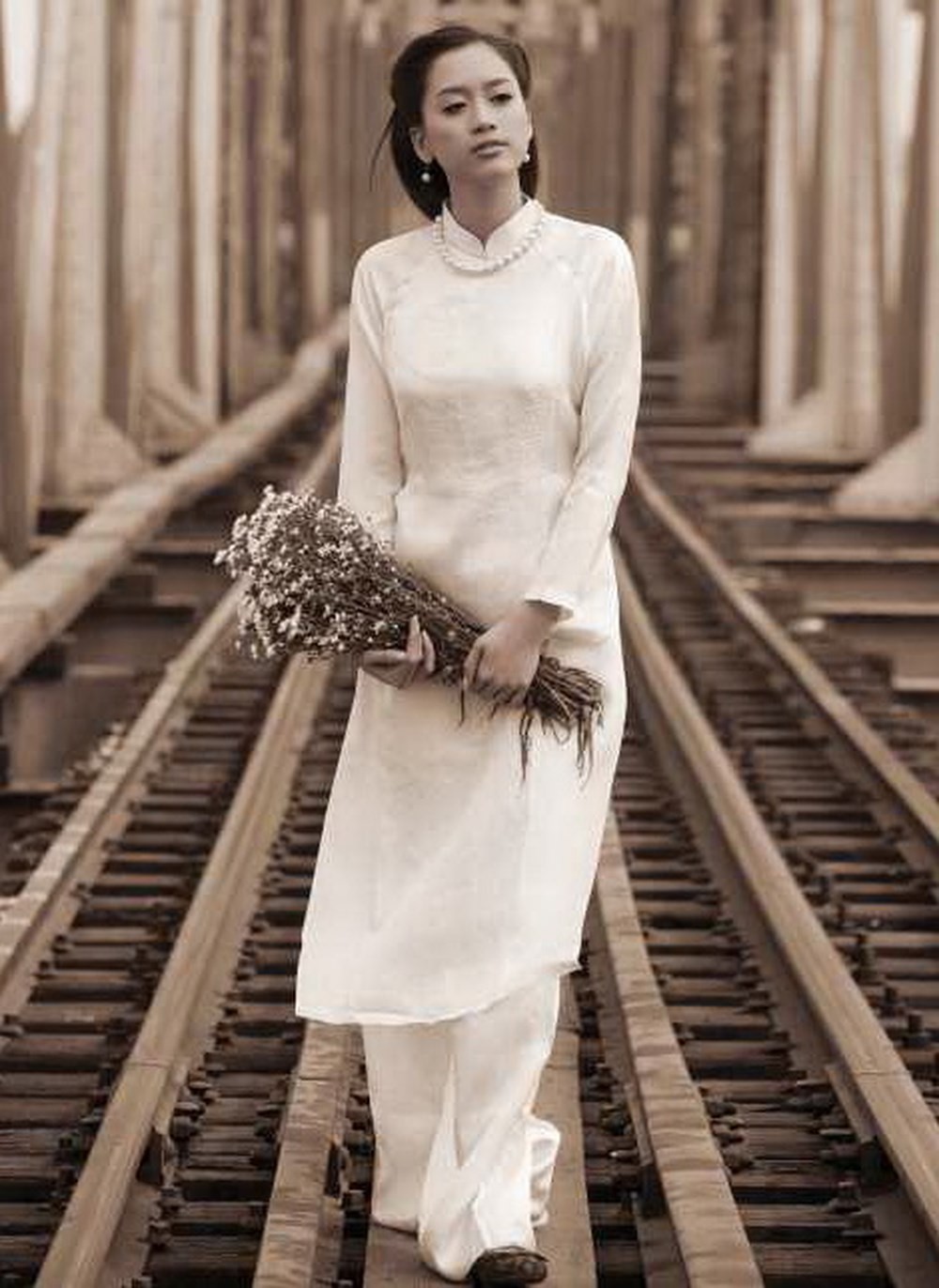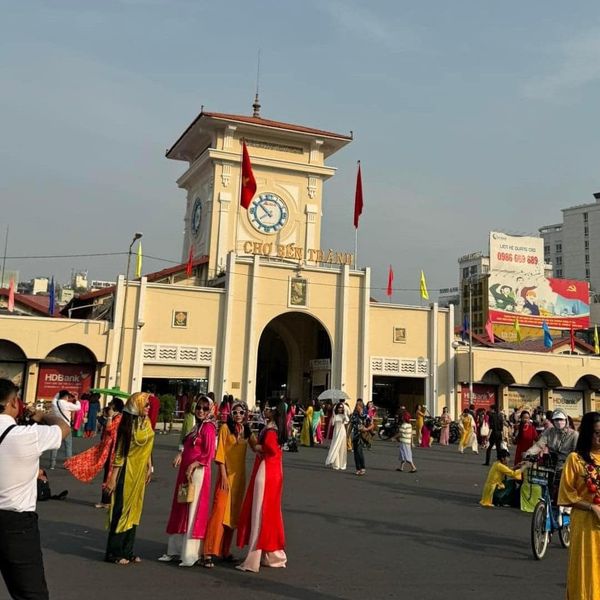THE ÁO DÀI IS A TRADITIONAL VIETNAMESE DRESS
- MONday - 05/02/2024 22:28
- Close page

The Áo Dài is a traditional Vietnamese dress
The Áo Dài is a traditional Vietnamese dress that is recognized for its elegant and graceful design. It is a symbol of Vietnamese culture and is commonly worn on special occasions, ceremonies, and festivals.
Origin of Vietnamese costume Ao Dai
The Ao Dai is a traditional Vietnamese costume that has a rich history and cultural significance. The origins of the Ao Dai can be traced back to the 18th century during the Nguyen Dynasty in Vietnam. However, its modern form has evolved over the years.
The term "Ao Dai" literally means "long dress." The traditional Ao Dai consists of a long, form-fitting tunic with long sleeves and high slits on either side, worn over loose-fitting trousers. It is typically worn with a non la (conical hat) and is considered a symbol of Vietnamese femininity and grace.

The history of Ao Dai
In the 18th century, the Ao Dai was initially worn by both men and women as a symbol of modesty and elegance. However, over time, it became more associated with women's fashion. During the French colonial period in Vietnam, Western influences began to shape the Ao Dai's design, incorporating elements such as collars and higher slits.
In the 20th century, especially during the 1930s and 1940s, the Ao Dai underwent further changes influenced by both Western and traditional Vietnamese styles. The modern form of the Ao Dai, characterized by a close-fitting top and flowing trousers, became popular in the 1950s and 1960s.
Today, the Ao Dai is not only worn on special occasions and traditional ceremonies but has also become a symbol of Vietnamese identity and cultural pride. It is worn by women of all ages for various events such as weddings, festivals, and formal ceremonies. The design and style of the Ao Dai continue to evolve, reflecting both tradition and contemporary fashion trends.

Ao Dai structure
The Ao Dai is a traditional Vietnamese costume known for its elegant and form-fitting design. The structure of the Ao Dai consists of two main components: the long tunic (Ao) and the wide-legged trousers (Dai). Here is a breakdown of the structure of the Ao Dai:
Ao (Tunic):
- Collar: The Ao Dai typically features a high, mandarin collar that extends up the neck. The collar can be rounded or rectangular.
- Sleeves: The sleeves of the Ao Dai are long and form-fitting. They extend all the way to the wrists and contribute to the overall graceful appearance.
- Bodice: The bodice of the tunic is closely tailored to the wearer's body, creating a slim and elegant silhouette. It may have darts or seams for a more fitted look.
- Slits: The tunic has long, vertical slits on both sides, usually starting from the waist down. These slits not only add to the aesthetics but also provide ease of movement.
Dai (Trousers):
- Wide-Legged Trousers: The trousers are wide-legged and loose-fitting. They are designed to provide comfort and ease of movement, contrasting with the form-fitting top.
- Waistband: The trousers typically have a high waistband that matches the color or complements the color of the tunic.
Accessories:
- Non La (Conical Hat): The traditional Ao Dai is often worn with a non la, a conical hat made of palm leaves or bamboo. The non la adds a cultural touch to the overall ensemble.
- Sash or Belt: Some Ao Dai may be worn with a sash or a belt around the waist, adding a decorative element and defining the waistline.
Fabric and Decorations:
- Fabric: Ao Dai can be made from various fabrics, including silk, satin, or other lightweight materials. The choice of fabric often depends on the occasion and personal preference.
- Decorations: Depending on the formality of the event, Ao Dai may be adorned with embroidery, lace, or other decorative elements. Traditional patterns and motifs may be incorporated into the design.

The Ao Dai's structure has evolved over time, and contemporary variations may feature different necklines, sleeve lengths, or decorative elements, reflecting a blend of tradition and modern fashion.
The meaning of the Ao Dai
The Ao Dai holds significant cultural and symbolic meanings in Vietnamese society. Here are some of the key meanings associated with the Ao Dai:
Elegance and Modesty:
The Ao Dai is renowned for its elegant and graceful design. Its form-fitting silhouette, high collar, and long sleeves contribute to a sense of modesty and refinement. The garment is often seen as a symbol of feminine beauty and grace.
Cultural Identity:
The Ao Dai is deeply rooted in Vietnamese culture and history. It is considered a national costume and represents a sense of identity and pride for the Vietnamese people. Wearing the Ao Dai is a way to connect with and honor traditional Vietnamese values.
National Symbol:
The Ao Dai is recognized internationally as a symbol of Vietnamese culture. It is often featured in cultural events, ceremonies, and representations of Vietnam around the world. The garment embodies the country's rich history and artistic heritage.
Traditional Values:
The Ao Dai reflects traditional values such as modesty, respect, and a sense of harmony. Its design emphasizes the balance between the form-fitting top and the flowing trousers, symbolizing the blending of traditional and modern influences.
Occasions and Celebrations:
The Áo Dài is worn on various occasions, including weddings, Tet (Lunar New Year) celebrations, and other important ceremonies. It is also commonly worn by students as a school uniform.

Fashion and Modern Expression:
While deeply rooted in tradition, the Ao Dai has evolved over time to incorporate modern fashion trends. Contemporary variations of the Ao Dai may feature different colors, fabrics, and embellishments, allowing individuals to express their personal style while still honoring the cultural significance of the garment.
Unity and Equality:
The Ao Dai has been embraced by people of different backgrounds and social classes. It is worn by women of all ages, and its popularity transcends various societal divisions, emphasizing unity and equality.
In essence, the Ao Dai is not just a piece of clothing; it is a cultural emblem that embodies the beauty of Vietnamese tradition, the values of modesty and grace, and a sense of national pride and identity.
CONTACT US:
*Address:
- 2 Paris Commune, Ben Nghe, District 1
- 241 Pham Ngu Lao St, Pham Ngu Lao Ward, District 1
*Website: https://vietcruisetours.com/
*Hotline/Whatsapp: +84 908.785.680
*Email: contact@vietcruisetours.com